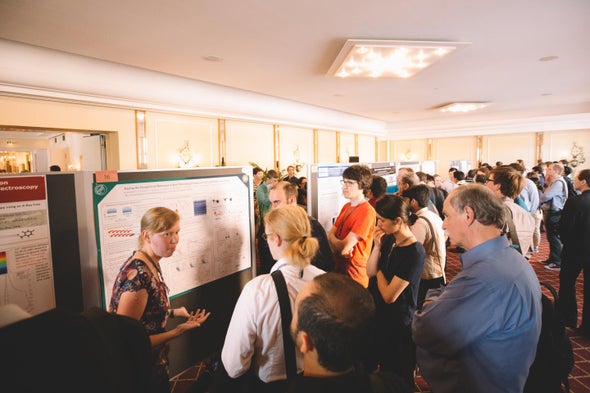(单词翻译:单击)
听力文本
This is Scientific American's 60-second Science, I'm Christopher Intagliata.
If you attend science conferences, ever pay attention to who in the audience asks questions? Geneticist Natalie Telis did. And she noticed something... off. "For the entire first day of the conference, I was the only woman to ask a question. And I thought, wow, that's kind of weird, right?"
So, being a scientist, she decided to systematically study who asks questions at scientific conferences. Together with colleagues at Stanford University, where she was based at the time, and others at Emory University in Atlanta, she recorded more than 2,000 questions from hundreds of talks at eight different scientific conferences.
After assigning either male or female designations to question askers—which the researchers acknowledge in the paper doesn't fully capture the spectrum of gender identity—they found that women ask far fewer questions than a representative result based on their numbers. In fact: "You need about 85 to 90 percent of your room to be women before 50 percent of your questions come from women."

But Telis did identify a possible solution. Halfway through the Biology of Genomes conference in 2015, Telis started tweeting some of her preliminary findings about how few women had been asking questions compared to their relative numbers at the meeting. That information sparked a public discussion—and a policy change from the conference organizers, who instituted a new rule that the first question at every talk had to come from a scientist still working towards her PhD, in the hope that the approach would produce a more diverse set of question-askers. And it worked.
"Before our intervention, about 11 percent of questions came from women, which is one third of what you'd expect. After our intervention, you get more like 35 percent of questions coming from women. It's actually what you'd expect from that audience."
The analysis is in the American Journal of Human Genetics.
Telis says that strategy of simply publicizing the problem has been effective at other conferences too, getting more women to not only attend, but to participate in scientific conferences.
"A lot of women have messaged me and said, 'Oh, you know, I asked my first question at a conference when I saw this work,' or stuff like that. And I hope that means people are taking advantage of that incredible opportunity to really add their voice, not just their face in the conference photo, to that scientific community."
Thanks for listening for Scientific American — 60-Second Science. I'm Christopher Intagliata.
参考译文
这里是科学美国人——60秒科学系列,我是克里斯托弗·因塔格里塔。
如果你参加过科学会议,那你有没有注意过观众中谁会提问?遗传学家娜塔莉·泰利斯注意了。她留意到了某些缺失的东西。“在整个第一天的会议中,我是唯一一个提问的女性。我当时想,哇哦,这有点奇怪,对吧?”
因此,作为一名科学家,她决定系统地研究谁会在科学会议上提问。她与当时所在的斯坦福大学的同事以及亚特兰大埃默里大学的研究人员一起,记录了8个科学会议上数百个对话中涉及的2000余个提问。
在给提问者指定男性或女性标志后,研究人员在报告中承认,他们没能充分捕捉到性别认同的范围——他们发现,女性的提问数量少于基于女性数量的代表性结果。事实上:“需要观众中有85%到90%都是女性,才能实现50%的问题来自女性。”
但泰利斯确实找到了一个可能的解决方案。2015年基因组生物学大会过半时,泰利斯开始在推特上发表她的一些初步发现,即与参加会议的女性相对人数相比,女性的提问数量有多少。这一信息引发了公众讨论——该会议组织者改变了政策,他们制定了一个新规则,要求每场对话的第一个提问必须来自仍在攻读博士学位的女科学家,希望这种方法能催生更多样的提问者。而该方法的确有效。
“我们介入之前,大约11%的提问来自女性。这是期望值的三分之一。而在我们干预之后,来自女性的提问增加到了35%。这确实是你对观众的期望。”
这项分析发表在《美国人类遗传学杂志》上。
泰利斯表示,简单地公开问题这种策略对其他会议同样奏效,能让更多的女性不仅参加,而且参与到科学会议中。
“很多女性给我发信息说,‘哦,我看到这篇研究后,在会议上提出了我的第一个问题’,或者类似的话。我希望这意味着人们正在利用这个不可思议的机会,真正地向科学界增加他们的声音,而不仅仅是在会议照片中增加面孔。”
谢谢大家收听科学美国人——60秒科学。我是克里斯托弗·因塔利亚塔。
译文为可可英语翻译,未经授权请勿转载!
重点讲解
重点讲解:
1. pay attention to 关心;注意;
More than ever before, the food industry is paying attention to young consumers.
食品工业比以往任何时候都更加关注年轻消费者。
2. together with 连同…一起;还有;加之;
Every month we'll deliver the very best articles, together with the latest fashion and beauty news.
每个月我们都登载最好的文章,还有最新的时尚美容资讯。
3. participate in 参加;参与;
Over half the population of this country participate in sport.
这个国家一半以上的人口参加体育锻炼。
4. take advantage of 利用;
I intend to take full advantage of this trip to buy the things we need.
我打算充分利用这次旅行来购买我们所需的物品。


